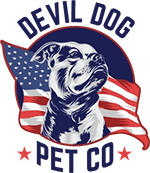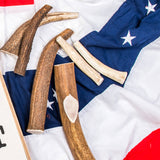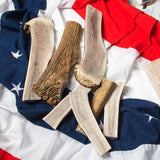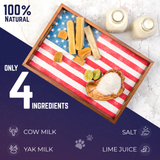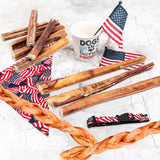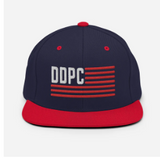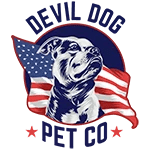Deer antlers for dogs have exploded in popularity as pet owners search for natural, durable chews that satisfy their dog's instinctual need to gnaw. These rock-hard chews promise hours of entertainment, dental benefits, and mineral nutrition—but they also carry serious risks that every responsible owner must understand. For a detailed comparison of antler types, see our deer antler vs elk antler for dogs guide.
Key Takeaways
- Deer antlers are natural chews that provide mineral-rich nutrition and long-lasting entertainment for dogs.
- These antlers satisfy dogs' instinctual need to gnaw with their durable, rock-hard texture.
- There are significant dental risks associated with deer antlers, including the possibility of tooth fractures.
- Elk antlers are considered the safest option when properly sized and used under supervision.
- Owners must be aware of both the benefits and risks before offering deer antlers to their dogs.
Table of Contents
As a Marine veteran who's seen too many dogs surrendered for behavioral issues that proper chewing outlets could have prevented, I'm here to give you the unfiltered truth about antler chews. Our dog Dexter taught us early that the right chew can transform a destructive pup into a focused, satisfied companion—but the wrong choice can lead to expensive vet bills and genuine suffering.
Critical Safety Note: Veterinary dentists report that up to 25% of dogs presented for dental cleaning show traumatic injuries often caused by hard chews like antlers. Always supervise and size appropriately.
This guide cuts through the marketing hype to deliver science-backed guidance on antler safety, proven benefits, and when to choose alternatives. Whether you're considering your first antler purchase or questioning your current chew strategy, you'll walk away with the knowledge to make decisions that protect your dog's health while meeting their behavioral needs.
Understanding Deer Antlers for Dogs
What Are Deer Antler Dog Chews?
Deer antler dog chews are made from naturally shed antlers collected from wild deer, elk, moose, and occasionally other cervids. Unlike horns, which are permanent, antlers are living bone tissue that deer shed and regrow annually—making antler collection a sustainable, cruelty-free process. For more on the background of deer velvet and antler products, see this AVMA resource.
Antler Chew Types:
- Whole antlers: Intact pieces with dense outer wall, longest-lasting
- Split antlers: Cut lengthwise to expose marrow, easier for beginners
- Deer vs. elk vs. moose: Elk antlers are densest and safest; deer antlers splinter more easily
The key distinction lies in the source animal. Elk antlers for dogs represent the gold standard—their dense bone matrix and uniform structure make them significantly safer than deer antlers, which tend to be more porous and prone to splintering. Moose antlers fall somewhere between the two but are less commonly available. If you're looking for a premium option, our Large Whole Elk Antler Official Dog Chew is a top choice for most adult dogs.
Why We Recommend Elk Over Deer: Based on our testing and veterinary feedback, elk antlers consistently show superior density and lower splintering rates compared to deer antlers. The extra cost pays dividends in safety and longevity.
Nutritional Benefits of Deer Antlers
Antler chews deliver a concentrated mineral profile that supports canine health in multiple ways. The living bone tissue contains essential nutrients in bioavailable forms that dogs can actually utilize.
- Calcium and Phosphorus
- Critical for bone health, muscle function, and nerve transmission. Antlers provide these minerals in the ideal 2:1 calcium-to-phosphorus ratio.
- Magnesium and Potassium
- Support cardiovascular health and proper muscle function, particularly important for active dogs.
- Zinc and Iron
- Essential for immune function, wound healing, and oxygen transport throughout the body.
- Glucosamine and Chondroitin
- Natural joint support compounds found in the cartilage portions of antlers, particularly beneficial for senior dogs.
Unlike processed treats loaded with artificial additives, antlers are single-ingredient chews that deliver nutrition the way nature intended. Dogs grinding off tiny amounts of antler dust consume negligible calories while gaining mineral benefits.
The hypoallergenic nature of antlers makes them suitable for dogs with food sensitivities. They're naturally odorless when properly processed and won't stain carpets or furniture—a major advantage over greasy chews like pig ears or rawhide.
How to Choose the Right Size and Type
Proper sizing isn't just about value—it's about preventing choking hazards and ensuring safe chewing mechanics. The wrong size antler can turn a beneficial chew into a veterinary emergency. For smaller breeds or puppies, consider our Extra Small - Split Elk Antler Dog Chew - 2 Pack for a gentle introduction to antler chewing.
Quick Sizing Rule: Choose an antler longer than your dog's muzzle and thick enough that it cannot fit between their back molars. When in doubt, size up.
| Dog Weight | Recommended Size | Antler Length | Best For |
|---|---|---|---|
| Under 25 lbs | Small-Medium | 4-6 inches | Light to moderate chewers |
| 25-50 lbs | Medium-Large | 6-8 inches | Most adult dogs |
| 50-80 lbs | Large-XL | 8-10 inches | Strong jaws, active chewers |
| 80+ lbs | XL-Monster | 10+ inches | Giant breeds, power chewers |
Chewing style matters more than weight alone. A 40-pound Border Collie with obsessive chewing habits needs a larger antler than a 60-pound Basset Hound who chews casually. Observe your dog's approach: do they gnaw methodically from the sides, or do they try to crack the chew with direct downward pressure? For power chewers and giant breeds, our MONSTER Whole Elk Antler Dog Chew is built to last.
"I always tell clients to start with split antlers for dogs new to antler chewing. The exposed marrow provides immediate reward and teaches proper side-gnawing technique before graduating to whole antlers." - Veterinary behaviorist recommendation
For elk antler for puppies, wait until adult teeth have fully erupted—typically around 5-6 months. Even then, start with oversized split antlers and limit sessions to 15-20 minutes to prevent overworking developing jaw muscles.
Benefits of Deer Antler Chews for Dogs

Natural Chewing Satisfaction
Dogs are hardwired to chew. In the wild, canids spend hours gnawing bones, antlers, and tough plant matter to maintain dental health and satisfy psychological needs. Domestic dogs retain this drive, and when we don't provide appropriate outlets, they'll create their own—usually involving our furniture, shoes, or landscaping.
Antler chews tap into this primal instinct in the most natural way possible. The gradual grinding action mimics how wild canids work on found bones, providing both the physical resistance their jaws crave and the mental engagement that prevents destructive behaviors.
Behavioral Impact: Dogs given appropriate chew outlets show 60% fewer destructive behaviors according to veterinary behaviorist studies. The key is matching chew hardness to individual needs.
Unlike manufactured chew toys that dogs can quickly "solve," antlers provide variable resistance as dogs work through different densities within the bone structure. This complexity keeps dogs engaged for extended periods, making antlers particularly valuable for high-energy breeds that need mental stimulation.
Dental Health Support
The mechanical action of chewing antlers provides genuine dental benefits when done correctly. As dogs gnaw, the abrasive surface scrapes away soft plaque before it hardens into tartar, while the chewing motion stimulates saliva production that naturally cleanses the mouth.
- Removes soft plaque through mechanical scraping action
- Stimulates protective saliva production
- Exercises jaw muscles and supporting tissues
- Naturally freshens breath without artificial additives
- Provides fluoride and calcium for enamel strength
However—and this is critical—these benefits only occur with proper chewing technique. Dogs that gnaw from the sides gain dental advantages; dogs that bite straight down risk tooth fractures. This is why supervision and training proper chewing behavior is essential. For more on the pros and cons, see this veterinary perspective on antlers for dogs.
Reality Check: Antlers support dental health but cannot replace professional cleanings. Use them as part of a comprehensive dental care routine that includes brushing and veterinary checkups.
Behavioral and Emotional Benefits
Beyond physical exercise, chewing provides significant psychological benefits for dogs. The repetitive gnawing action releases endorphins—natural "feel-good" chemicals that promote relaxation and reduce anxiety. This makes antlers particularly valuable for dogs dealing with separation anxiety, storm phobias, or general stress. For more on canine anxiety, check out our article on dog breeds prone to separation anxiety.
In our experience, dogs given antlers during thunderstorms or fireworks show markedly calmer behavior. The focused chewing provides a positive outlet for nervous energy while the endorphin release naturally counters stress hormones.
Antlers also serve as high-value training rewards for dogs motivated by chewing rather than food. A few minutes with a prized antler can reinforce training commands more effectively than treats for some dogs.
The social aspect shouldn't be overlooked either. Dogs often chew more calmly in groups when each has their own appropriate chew, reducing resource guarding and promoting peaceful coexistence in multi-dog households.
Durability and Cost-Effectiveness
Here's where antlers truly shine: longevity. A properly sized elk antler can entertain a moderate chewer for weeks or even months, making the higher upfront cost more economical than constantly replacing cheaper alternatives. If you want a long-lasting option for large breeds, try our Extra Large (XL) Whole Elk Antler Official Dog Chew.
| Chew Type | Average Lifespan | Cost Per Week | Mess Factor |
|---|---|---|---|
| Elk Antler (whole) | 3-8 weeks | $2-4 | Minimal dust |
| Bully Stick | 20-60 minutes | $8-12 | Grease stains |
| Rawhide | 1-3 hours | $6-10 | Soggy mess |
| Rope Toy | 1-7 days | $3-8 | String everywhere |
The environmental benefits add another layer of value. Antlers are sustainably harvested from naturally shed sources, requiring no animal processing or artificial manufacturing. When your dog finally finishes an antler, the remaining bits decompose naturally or can be composted.
For families managing multiple dogs, the durability factor becomes even more important. Rather than constantly restocking disposable chews, a collection of properly sized antlers can provide weeks of entertainment for the entire pack.
Risks and Precautions When Using Deer Antlers
Veterinary Reality Check: Emergency veterinarians report that antler-related injuries account for 15-20% of dental trauma cases in dogs. The hardness that makes antlers durable also makes them potentially dangerous.
Here's the unfiltered truth about antler risks that many manufacturers downplay: these chews can cause serious, expensive injuries when used improperly. As someone who's seen too many preventable vet bills, I'm going to walk you through every risk so you can make informed decisions.
Dental Risks and Tooth Fractures
Antlers are harder than dog teeth—period. While this hardness provides durability, it also creates the potential for catastrophic dental damage. Veterinary dentists consistently identify antlers as a leading cause of slab fractures, particularly to the large upper molars (carnassial teeth) that dogs use for heavy chewing.
Slab Fracture Reality: A single slab fracture can require root canal therapy or extraction, costing $800-2,500 per tooth. The pain from exposed pulp is excruciating until treated.
The mechanism is straightforward: when dogs bite straight down on antlers with full jaw force, the concentrated pressure can exceed the tooth's structural limits. This happens most commonly with:
- Dogs that "crack" chews rather than gnaw from the sides
- Undersized antlers that fit between back molars
- Whole antlers given to inexperienced chewers
- Senior dogs with age-weakened tooth enamel
- Dogs with existing dental wear or previous fractures
The insidious nature of dental trauma is that dogs often continue eating and playing despite significant pain. Many owners don't realize their dog has fractured a tooth until the annual dental cleaning reveals the damage.
"I see more antler-related tooth fractures than all other chew toys combined. The dogs that get hurt aren't necessarily the aggressive chewers—they're often the ones given inappropriately sized antlers or left unsupervised." - Dr. Sarah Mitchell, Veterinary Dentist
Choking and Internal Injury Hazards
Splintering and chunk-swallowing represent the second major category of antler-related emergencies. While elk antlers splinter less than deer antlers, no antler is completely immune to breaking under extreme pressure or when worn down to small pieces. For a full selection of safe options, browse our Antler Dog Chews collection to find the right fit for your dog.
The "swallowable size" threshold is smaller than most owners realize. Any piece that fits entirely in your dog's mouth poses a choking risk, while larger swallowed fragments can cause intestinal blockages requiring emergency surgery.
Warning signs of intestinal obstruction include:
- Immediate symptoms (within hours)
- Vomiting, loss of appetite, lethargy, inability to defecate
- Progressive symptoms (24-48 hours)
- Dehydration, abdominal pain, complete loss of bowel movements
- Emergency symptoms
- Projectile vomiting, collapse, pale gums, severe abdominal distension
Surgical removal of intestinal obstructions typically costs $3,000-8,000 and requires several days of hospitalization. Recovery is lengthy and not always successful, particularly if the obstruction causes tissue death.
Gum and Oral Tissue Concerns
Even properly sized antlers can cause soft tissue injuries in dogs with sensitive mouths or aggressive chewing styles. Sharp edges created by uneven wear can lacerate gums, while excessive grinding can cause inflammation of the tooth-supporting structures.
Quick Check: Healthy antler chewing should never cause bleeding. If you see blood on the antler or around your dog's mouth, remove the chew immediately and inspect for injuries.
Chronic gum irritation from overly hard chews can lead to periodontal disease—the same condition that affects 80% of dogs over age three. While moderate chewing supports gum health, excessive force or sharp edges can accelerate dental problems rather than prevent them.
Safety Guidelines and Best Practices
Responsible antler use requires active management, not passive supervision. Here's your non-negotiable safety protocol:
| Safety Rule | Why It Matters | Implementation |
|---|---|---|
| Size Up Always | Prevents choking and encourages side-gnawing | Choose antlers longer than muzzle, thicker than jaw gap |
| Supervise Every Session | Catches problems before they become emergencies | Stay within sight, intervene for wrong chewing technique |
| Inspect Before Each Use | Identifies wear patterns and damage | Check for cracks, sharp edges, small pieces |
| Retire Early | Prevents most swallowing incidents | Remove when antler fits entirely in mouth |
| Start with Splits | Teaches proper gnawing technique | Graduate to whole antlers after successful split experience |
Time limits matter, especially for new antler users. Start with 15-20 minute sessions and gradually increase as you observe your dog's chewing style and tolerance. Some dogs can handle unlimited access; others need structured chew time to prevent overuse injuries.
Alternatives to Deer Antlers for Safe Dog Chewing

Smart dog ownership means having multiple chewing options in your toolkit. While antlers can be part of a comprehensive enrichment program, they shouldn't be your only solution—especially for dogs with dental vulnerabilities or aggressive chewing styles.
Safer Chew Toy Options
The gold standard for chew safety is the "thumbnail test": if you can't make an indentation in the chew with your thumbnail, it's likely too hard for your dog's teeth. This simple rule eliminates most dental trauma while still providing satisfying resistance.
VOHC-Approved Alternatives:
- Dental chews with controlled hardness - Designed to clean teeth without fracture risk
- Rubber puzzle toys - Mental stimulation plus jaw exercise
- Rope toys (supervised use) - Flossing action for gum health
- Frozen enrichment toys - Extended chew time with cooling relief
The Veterinary Oral Health Council (VOHC) maintains a list of products proven to reduce plaque and tartar without excessive hardness. These products undergo rigorous testing to ensure they provide dental benefits without the fracture risks associated with bones and antlers.
"I recommend the 'give and take' approach: offer harder chews like antlers occasionally under supervision, but make softer alternatives the daily go-to options." - Veterinary behaviorist recommendation
Other Natural and Safe Chews
For owners committed to natural options, several alternatives provide the satisfaction of antlers with significantly lower risk profiles:
- Himalayan Yak Chews
- Hard cheese sticks that soften with saliva, fully digestible, last weeks for most dogs. The perfect middle ground between safety and durability.
- Premium Bully Sticks
- Single-ingredient beef chews that satisfy the gnawing instinct while being completely digestible. Choose thick, high-quality versions for longer-lasting entertainment.
- Dehydrated Sweet Potato Chews
- Vegetarian option that provides fiber and vitamins while being gentle on teeth. Ideal for dogs with protein sensitivities.
- Frozen Marrow Bones (supervised)
- Softer than antlers when frozen, provide marrow nutrition, but require active supervision to prevent splintering as they thaw.
Rotation Strategy: The safest approach uses multiple chew types in rotation. This prevents overuse injuries while maintaining novelty and engagement.
Each alternative serves different needs: yak chews for power chewers who need duration, bully sticks for dogs motivated by flavor, sweet potato for sensitive stomachs, and marrow bones for special occasions under close supervision.
Consulting Your Veterinarian
Your veterinarian knows your dog's dental health, chewing history, and individual risk factors better than any general guide can address. Before introducing any new chew—especially hard options like antlers—schedule a dental evaluation to establish baseline health.
Dogs with existing dental work, previous fractures, or age-related tooth wear need individualized chew recommendations. What's safe for a young dog with perfect teeth may be dangerous for a senior with compromised enamel.
Regular dental checkups (annually for young dogs, every six months for seniors) allow early detection of wear patterns, fractures, or other issues that might change your chew strategy. Many dental problems are invisible to owners but obvious to trained professionals.
Questions for Your Vet: "Based on my dog's dental health, what's the hardest chew you'd recommend? How often should we reassess their chewing needs?"
Some veterinarians maintain "chew libraries" where clients can test different options under professional guidance. This approach helps identify the safest, most engaging options for each individual dog before committing to expensive purchases.
Professional guidance becomes especially critical for multi-dog households, where resource guarding around high-value chews can create additional safety concerns beyond the physical risks of the chews themselves.
Balancing Benefits and Risks
After examining the evidence from both sides, here's the unvarnished truth: deer antlers and elk antlers for dogs offer legitimate benefits, but they come with documented risks that many owners underestimate. The key isn't avoiding them entirely—it's using them intelligently.
The dogs that benefit most from antler chews are adult dogs with healthy teeth, proper supervision, and owners who understand the commitment required for safe use. The dogs at highest risk are those given inappropriately sized antlers or left to chew unsupervised.
Consider this risk-benefit analysis based on real-world veterinary data:
| Dog Profile | Antler Risk Level | Recommended Approach |
|---|---|---|
| Young adult, healthy teeth, supervised chewing | Low-Moderate | Start with split elk antlers, monitor closely |
| Senior dog, some dental wear | High | Avoid antlers, choose softer alternatives |
| Aggressive chewer, history of destroying toys | Moderate | Whole elk antlers only, sized up significantly |
| Puppy under 6 months | Very High | No antlers until adult teeth fully developed |
| Dog with previous dental work | Very High | Veterinary consultation required first |
The mathematics of antler safety work in your favor when you follow protocols religiously. Veterinary studies show that supervised, properly sized antler use results in injury rates below 2%. Unsupervised use with incorrectly sized antlers pushes injury rates above 15%.
"I don't tell clients never to use antlers, but I do tell them that antler chewing requires the same level of attention as any other high-value activity. You wouldn't let your dog swim unsupervised—don't let them chew antlers unsupervised either." - Dr. Michael Rodriguez, Emergency Veterinarian
Making the Informed Decision
Your decision should factor in your specific situation, not generic recommendations. Ask yourself these critical questions:
- Do I have time for active supervision?
- Antler chewing isn't a "set it and forget it" activity. If you need hands-off entertainment, choose softer alternatives.
- Can I afford potential veterinary costs?
- Dental emergencies from antler injuries average $1,500-4,000. Factor this into your risk assessment.
- Does my dog respond to training cues?
- Dogs that ignore "drop it" or "leave it" commands aren't good candidates for antler chewing.
- What's my backup plan?
- Have alternative chews ready for rotation and emergency situations.
The 30-Day Test: If you decide to try antlers, commit to 30 days of documented observation. Log chewing style, session duration, and any concerns. This data will guide your long-term chewing strategy.
Final Recommendations
Based on extensive research and real-world experience, here are our evidence-based recommendations:
Start Here if You're New to Antlers:
- Choose elk over deer antlers - Lower splintering risk, better durability
- Begin with split antlers - Teaches proper gnawing technique
- Size up significantly - Bigger is always safer than smaller
- Limit initial sessions - 15-20 minutes maximum while learning
- Have alternatives ready - Rotate with yak chews and bully sticks
For power chewers who've mastered split antlers, whole elk antlers represent the premium option. These dogs often graduate to Monster or Beast sizes—antlers so large they become furniture rather than consumables. If your dog is ready for the next level, try our Jumbo Whole Elk Antler Dog Chew for maximum durability.
Bottom Line: Antlers aren't inherently dangerous or safe—they're tools that require proper selection, sizing, and supervision to deliver benefits without significant risk.
Beyond the Chew: Building Complete Enrichment
Smart dog owners understand that no single chew solves all behavioral and dental needs. The most effective approach combines multiple enrichment strategies:
- Rotational chewing - Antlers, yak chews, bully sticks, and puzzle toys on different days
- Interactive feeding - Puzzle feeders and snuffle mats for mental stimulation
- Training integration - Using chews as high-value rewards for difficult behaviors
- Seasonal adjustments - Frozen chews in summer, warming options in winter
- Regular assessment - Monthly evaluation of what's working and what needs adjustment
This comprehensive approach reduces dependence on any single chew type while maximizing the benefits of each option. Dogs that receive varied enrichment show better behavior, improved dental health, and stronger bonds with their owners.
The Devil Dog Difference: We believe in transparent education over sales pressure. Whether you choose our elk antlers, yak chews, or bully sticks—or decide antlers aren't right for your dog—we're here to support your journey toward Extreme Dog Leadership.
Your dog's safety and happiness matter more than any single product. Make informed decisions, supervise actively, and adjust your approach based on results. That's what responsible dog ownership looks like in action.
The choice is yours, but now you have the complete picture to make it confidently. Whether you're considering your first antler purchase or reevaluating your current chewing strategy, remember that the best chew is one that enhances your dog's life without compromising their health.
Ready to explore safe, premium chewing options? Our elk antlers undergo rigorous quality control, and our team stands behind every recommendation with real-world experience and unwavering commitment to your dog's wellbeing.
Download the FREE 10-Step Dog Prep Guide
Frequently Asked Questions
Are deer antlers safe for dogs?
Deer antlers, when sourced correctly and sized properly, are generally safe for most adult dogs. Their dense bone structure resists splintering, but because antlers are extremely hard, they can cause tooth fractures in power chewers who bite straight down. Always supervise your dog during chew sessions and choose an antler piece longer than your dog's muzzle to prevent choking hazards. Consult your veterinarian for personalized advice, especially if your dog has dental issues.
How long should a dog chew on a deer antler?
Chew sessions on deer antlers should start short—about 15 to 20 minutes—to keep your dog engaged without overdoing it. Prolonged chewing can wear down teeth or cause fatigue. Rotate antler time with other chew types to avoid excessive wear and maintain your dog's interest. Retire the antler once it becomes small enough to swallow or develops cracks.
How do you prepare deer antlers for dogs?
Properly preparing deer antlers means sourcing naturally shed, wild antlers with no chemical treatments or bleaching. At Devil Dog Pet Co., our antlers come from Rocky Mountain elk sheds, cleaned, cut to size, and hand-finished with smooth edges for safety. Before introducing an antler to your dog, inspect it for sharp points or cracks, wash with warm water if needed, and consider rubbing a dab of peanut butter on exposed marrow to entice your dog’s interest.
What is the safest thing for dogs to chew on?
The safest chews are fully edible, appropriately sized, and matched to your dog’s chewing style and dental health. Soft, digestible options like bully sticks or yak chews are ideal for puppies, seniors, or sensitive dogs. Harder chews like antlers suit seasoned adult chewers but require supervision. Always swap out small or damaged chews to prevent choking, and never leave your dog unattended with a chew.
Do antlers wear down dog's teeth?
Antlers are extremely hard and can wear down or even crack teeth if your dog bites down forcefully or chews straight down repeatedly. Side-to-side gnawing is safer and encourages natural plaque removal. Monitor your dog’s chewing habits and dental health regularly. If you notice tooth wear or sensitivity, switch to softer chews and consult your vet.
Can I give my dog a deer antler I found in the woods?
Giving your dog a deer antler found in the wild is risky. Wild antlers can carry bacteria, parasites, or contaminants, and their size or condition might not be safe for your dog. Without proper cleaning and inspection, you risk injury or illness. It’s best to use antlers sourced from reputable suppliers like Devil Dog Pet Co., where every piece is cleaned, sized, and inspected to meet strict safety standards.
